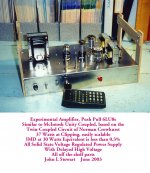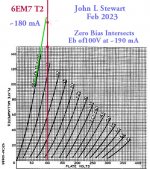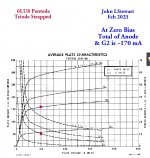For fans of the 6LU8 here is the G2 Reg using one. But this time with a -150V Reference.
Easy to do with the glow of an 0A2 or VR150. Negative Supply derived from the regular CT HV PT.
The dynamic resistance of these gas tubes is ~1K, A simple RC network will get to -150V
with say 10 mA from the neg HV.
I built a clone of Norman Crowhurst's Twin Coupled Amp using PP 6LU8s about 20 yrs ago.
The circuit is a Poor Man's McIntosh, Unity Coupling. An easy 30W, all off the shelf parts.
The PS on that one is all SS with slow run up of the HV. And no boutique parts crap at all. 👍
Easy to do with the glow of an 0A2 or VR150. Negative Supply derived from the regular CT HV PT.
The dynamic resistance of these gas tubes is ~1K, A simple RC network will get to -150V
with say 10 mA from the neg HV.
I built a clone of Norman Crowhurst's Twin Coupled Amp using PP 6LU8s about 20 yrs ago.
The circuit is a Poor Man's McIntosh, Unity Coupling. An easy 30W, all off the shelf parts.
The PS on that one is all SS with slow run up of the HV. And no boutique parts crap at all. 👍
Attachments
How many G2 milliamps of total current could be safely handled by this 6LU8 regulator? Even 2 pairs of PP 6CW5s will require 60+ ma on peaks, although average is probably 10-15 ma for the quad.
That information is available on the respective data sheets.How many G2 milliamps of total current could be safely handled by this 6LU8 regulator
NA in this thread. The nCW5 family does not operate at 450V B+.
What are you trying to do??
That regulator could be used as less B+. Say, 300 would probably be safe - the Hohner amps in the other thread were being run way north of 300.
If you started out with 300 and regulated to 200 you‘d be limited to 150mA (Peak). That’s just all you get at 100V plate and screen. For even lower voltage differentials you need those high perveance triodes (and live with the low gain). At 50 volts plate to cathode, that 6EM7 beats the 6LU8 by almost a factor of two on current.
When I threw out the idea of the idea of using the LU8 it was with the idea of cutting a 400V B+ in half, for G2’s on tubes a wee bit bigger than a CW5. Using tubes like this for a regulator opens up some possibilities without resorting to having lower voltage supply taps on the power trafo to get the g2.
If you started out with 300 and regulated to 200 you‘d be limited to 150mA (Peak). That’s just all you get at 100V plate and screen. For even lower voltage differentials you need those high perveance triodes (and live with the low gain). At 50 volts plate to cathode, that 6EM7 beats the 6LU8 by almost a factor of two on current.
When I threw out the idea of the idea of using the LU8 it was with the idea of cutting a 400V B+ in half, for G2’s on tubes a wee bit bigger than a CW5. Using tubes like this for a regulator opens up some possibilities without resorting to having lower voltage supply taps on the power trafo to get the g2.
That information is available on the respective data sheets.
Yes, I realize the “information is in the data sheets”. So, I could design my own G2 regulator. But since you have done it I don’t have to.
It seems like a reasonable question to ask - what current your 200V regulator in #21 could supply. The schematic (#21) shows 20 ma flowing through a 10k screen load. I will need more than 20 ma for a screen regulator, hence my question.
Sorry, I don’t know what “NA in this thread” means.NA in this thread. The nCW5 family does not operate at 450V B+.
What are you trying to do??
I realize nCW5 family does not operate at 450V; I plan to experiment with a plate to cathode voltage between 250 and 300V and screen regulated to around 200V. I have a SS regulator schematic, but thought a glass regulator should be considered, when you started this thread.
Last edited:
@wg_ski,That regulator could be used as less B+. Say, 300 would probably be safe - the Hohner amps in the other thread were being run way north of 300.
If you started out with 300 and regulated to 200 you‘d be limited to 150mA (Peak). That’s just all you get at 100V plate and screen. For even lower voltage differentials you need those high perveance triodes (and live with the low gain). At 50 volts plate to cathode, that 6EM7 beats the 6LU8 by almost a factor of two on current.
When I threw out the idea of the idea of using the LU8 it was with the idea of cutting a 400V B+ in half, for G2’s on tubes a wee bit bigger than a CW5. Using tubes like this for a regulator opens up some possibilities without resorting to having lower voltage supply taps on the power trafo to get the g2.
Thanks for your helpful reply, that is what I wanted to know. I wil take a closer look at the 6EM7 version, but if the LU8 could supply 150 ma peaks at 200 V that should be plenty for screen supply of four nCW5s in PP pairs.
Careful - like I said I said, if you drop to only 250 B+ the LU8 simply won’t be able to pass as much current. Not a matter of safety, it will just limit. At that voltage the EM7 might be better. If you like compactrons instead try to find 6FY7’s (I’m looking, it’s on the short list), or the 6CY7 in the mini 9 pin. The CW5 should run fine on 300. A lot of those little 110V AC/DC output tubes (like 50C5) will run at 300 without issue as long as you keep the screen down where it should be.
Some good points there. But digging deeper we find this in the attachments, not even close to 2:1 regards to peak current at 100V on the plate.When I threw out the idea of the idea of using the LU8 it was with the idea of cutting a 400V B+ in half, for G2’s on tubes a wee bit bigger than a CW5. Using tubes like this for a regulator opens up some possibilities without resorting to having lower voltage supply taps on the power trafo to get the g2.
In the Sim cct the results for each version are very close to each other.. And we don't run music amplifiers full out for extended periods. Except guitar pickers. The 6LU8 family, 6LR8 & so on can dissipate 15W while the 6EA7 manages 11W, Take your pick.
Got a schema of a typical Hohner amp?
Attachments
May as well drop that one sooner than later, it can dissipate only 7W.If you like compactrons instead try to find 6FY7’s (I’m looking, it’s on the short list),
And forward drop is more than the others here in the thread. 👎
Attachments
Forward voltage drop about the same as the EM7. Both are more than LU8 at only 50 volts. At 150+ that LU8 eats everybody else for breakfast. With only 50 volts of drop, the dissipation will be under 7 watts - shouldn’t be an issue unless you drop it out of regulation.
EM7 has nicer looking linear amplifier curves.
EM7 has nicer looking linear amplifier curves.
How about a schematic of what you think will work best? And some expected voltages & currents & the reasons why? 🙂
OK, Shew us a schematic of what you think would work for your project. NA simply means 'not applicable'.Yes, I realize the “information is in the data sheets”. So, I could design my own G2 regulator. But since you have done it I don’t have to.
The title on the thread clearly sez a 200V G2 regulator for TV sweep toobz. Nothing to do with ordinary audio tubes at all. 🙂
I don’t call a 6CW5 an “ordinary audio tube”. It is sort of like an EL84 that’s been adapted to work as a vertical sweep tube or an audio output. To run them to full capability, they need to be treated like sweep tubes - run the g2 significantly lower than B+. Greater current capability and apparently more ruggedness than the 6/12W6’s I was previously toying around with, and those were designed to be dual purpose.
But mainly because the *CW5 can still be had for reasonable prices (since you can’t just drop them into your Vox guitar amp, they haven‘t jacked prices thru the roof yet). The premium price is the hallmark of “ordinary audio tubes”.
But mainly because the *CW5 can still be had for reasonable prices (since you can’t just drop them into your Vox guitar amp, they haven‘t jacked prices thru the roof yet). The premium price is the hallmark of “ordinary audio tubes”.
Compactron tubes are wonderful to play with. I made an entire buffer using a 8BU11/6BH11 (same tube with different heater voltage, ignore why used different part number lettering) with very few passive components.
Unfortunately in the country I was born and live, to import tubes seems to be prohibited because they are considered dangerous, but lots of foolery containing lithium batteries are imported.
Unfortunately in the country I was born and live, to import tubes seems to be prohibited because they are considered dangerous, but lots of foolery containing lithium batteries are imported.
Importing tubes is dangerous. Especially old TV tubes.
The practice may turn you into some sort of terrorist. Rebelling against the lead-free, only good for 5000 thermal cycles before it’s ruined, throw it away BUY a new one society is bad for business. I’m really surprised they’re not cracking down on it in more places.
Most of the multi-dissimilar-element tubes I’ve been messing with are the triode/pentode variety in the mini 9 pin. One bottle makes a nice high gain block, many will do 5+ watts in a pair as a power amp, or drive 100 ohm loads as a follower. I’m working on a preamp loaded with 23 of them. No need to spend $30 a bottle to retube after 10 years, either. Hell, a damn 12AX7 might go for many times that much by then.
The practice may turn you into some sort of terrorist. Rebelling against the lead-free, only good for 5000 thermal cycles before it’s ruined, throw it away BUY a new one society is bad for business. I’m really surprised they’re not cracking down on it in more places.
Most of the multi-dissimilar-element tubes I’ve been messing with are the triode/pentode variety in the mini 9 pin. One bottle makes a nice high gain block, many will do 5+ watts in a pair as a power amp, or drive 100 ohm loads as a follower. I’m working on a preamp loaded with 23 of them. No need to spend $30 a bottle to retube after 10 years, either. Hell, a damn 12AX7 might go for many times that much by then.
"Importing tubes is dangerous. Especially old TV tubes.".
Sorry, I can't see why if they are maintained in they original closed box. Again, myriads of lithium batteries inserted in multiple electronic devices from small toys to big cars capable of self ignite are infinitely more dangerous.
Sorry, I can't see why if they are maintained in they original closed box. Again, myriads of lithium batteries inserted in multiple electronic devices from small toys to big cars capable of self ignite are infinitely more dangerous.
The tubes themselves are harmless, unless one is stupid enough to eat glass. The ideology of using them just goes against all the mierde de toro they are trying to cram down our throats. Thats more motivation for a ban than some trace amount of heavy metal.
With a lot of distortion. You've probably looked at the plate curves often. The info is all there.or drive 100 ohm loads as a follower.
Why don't you draw a 100R loadline on the plate curves for the toobz you are talking about?
And from that see what D% is?
Lots of talk but still no schematic of how you would do your required circuit.
Unfortunately that seems typical on DIY. Not many real live designers. Just a fog of BS.
Easy & clean to do what is required for your application with a NFET & a few Zenrs tho. 😀
Here we are a day later & no Reg PS schematics from the folks who assured us they could design the cct required.
Didn't even throw darts at this one. 😀
Here is one of many possible solutions for the PP 6CW5 Amps. I'll leave it to others to select a proper PT.
The G2 regulator has an internal impedance of 1.61R ( 45,08 mV / 28 mA ), at 77 mA load, read it off the AC ripple meters.
Not long after the Earth cooled ordinary people were solving these kinds of problems with nothing more than
pencil, paper & slide rule. They got the required toob data straight off the respective data sheets. Just like others do today.
Something anyone can do with the help of a simple 4-function calculator, no logarithm etc to get in the way.👍
Didn't even throw darts at this one. 😀
Here is one of many possible solutions for the PP 6CW5 Amps. I'll leave it to others to select a proper PT.
The G2 regulator has an internal impedance of 1.61R ( 45,08 mV / 28 mA ), at 77 mA load, read it off the AC ripple meters.
Not long after the Earth cooled ordinary people were solving these kinds of problems with nothing more than
pencil, paper & slide rule. They got the required toob data straight off the respective data sheets. Just like others do today.
Something anyone can do with the help of a simple 4-function calculator, no logarithm etc to get in the way.👍
Attachments
Thank you. This screen supply regulator seems to deliver what I expect to need for a future amplifier with 6CW5 tubes. Sorry if I derailed your thread.
- Home
- Amplifiers
- Tubes / Valves
- A 200V PS for use with TV Horizontal Sweep Tubes




